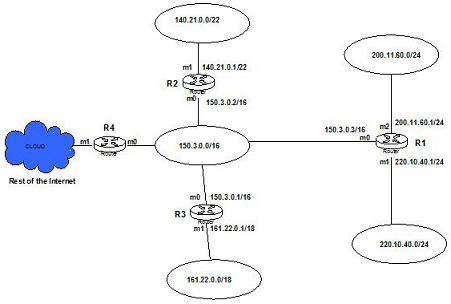Reference no: EM131203595
COIT20261 Network Routing and Switching Assignment-
Objectives - This assessment task requires you to demonstrate your knowledge of basic routing concepts by completing a number of exercise questions.
Instructions - You must do this assignment individually, that is, on your own.
Question 1 - routing table construction
Given the following network, construct the routing table for routersR2 and R3.Be sure to include the default route.

Question 2- Allocating subnets from a block
ABEC Pty Ltd (a public company)has been granted a block of addresses starting with the address 172.154.60.0/24.
a) Calculate the total number of addresses in this block. Show your calculation.
b) The company has decided to distribute the addresses on a departmental basis, with Dept#1 requesting120 addresses, Dept#2 requiring 60 addresses, Dept#3 needing 30 addresses and Dept#4 wanting 12 addresses.
Create the 4 subnets for the company. For each subnet, list the subblock address along with its subnet mask in CIDR format. Show your calculations for all subnets.
c) How many addresses are left unallocated? Show your calculation.
Question 3 - Fragmentation
An Ethernet packet 1,500 bytes long arrives at a router, which determines that the next destination is an X.25 network. Do the following, being sure to show your calculations and explain your reasons.
a) Assuming that the router decides to fragment the packet into 3 fragments, determine the size of each fragment, and identify their starting byte and end byte.
b) Calculate the fragmentation offset for each fragment.
c) Under what specific condition would the router decide not to fragment the packet and in that case how would the packet be treated? Be as precise as possible in your answer.
Question 4 - Advanced routing study
Research and review appropriate materials, including the textbook, and answer the first two questions (a & b).
a) Define the terms and discuss the relationship between Autonomous Systems, Inter-domain routing, and Intra-domain routing.
b) Identify the major routing protocols associated with Inter-domain and Intra-domain routing and list their similarities and differences. Finish by commenting on why we need different protocols for Inter-domain and Intra-domain routing.
Study the two articles listed below- both are freely available on the Internet. You may use other references in addition to these, as needed. Then answer the remaining 3 questions (c, d & e).
c) Briefly summarize in your own words the problems with current routing methods that the authors have identified.
d) Contrast and compare the concepts of embedded routing and extensible routing.
e) How does the proposal of Routing As A Service (RAAS or just RAS) address the problems with current routing methods?
The two articles for questions 3 - 5 (both articles have the same title):
1. Routing as a Serviceby K.Lakshminarayanan et al can be found at:
https://www.eecs.berkeley.edu/Pubs/TechRpts/2006/EECS-2006-19.pdf
2. Routing as a Service by K.Lakshminarayanan, Stoica, and Shenker can be found at:
https://www.cs.princeton.edu/~jrex/teaching/spring2005/reading/ras04.pdf
Question 5- IPv6 Packets
The following problem is adapted from Practice Set 27.7 Exercise #2 from the textbook.
Case: An IPv6 packet consists of a base header and a TCP segment. The data is 128,000 bytes long (jumbo payload).
a) Draw a diagram of this packet that shows and labels all the base header fields, the Hop-by-hop Extension header fields, and the TCP segment fields.
b) Place a correct value in the following fields in the base header with a brief explanation for the value you selected:
Version; Payload Length; Next Header; Hop limit: Source Address; Destination Address
Suggested sources of information: Forouzan (textbook) chapter 27
https://ptgmedia.pearsoncmg.com/imprint_downloads/cisco/promotions/clnwebinars/9781587143137_ch02.pdf
https://www.cu.ipv6tf.org/literatura/chap3.pdf
Do not type answers here: type it in the Answers Template provided.
Attachment:- TEMPLATE.rar